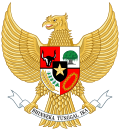Second Revised Dwikora Cabinet Kabinet Dwikora Yang Disempurnakan Lagi | |
|---|---|
| 25th Cabinet of Indonesia | |
| 1966 | |
 | |
| Date formed | 30 March 1966 |
| Date dissolved | 25 July 1966 |
| People and organisations | |
| Head of state | Sukarno |
| Head of government | Sukarno |
| No. of ministers | 102 ministers |
| History | |
| Predecessor | Dwikora II Cabinet |
| Successor | Ampera I Cabinet |
| ||
|---|---|---|
Pre-independence Domestic policy Foreign policy Family | ||
| Gallery: Picture, Sound, Video | ||
The Second Revised Dwikora Cabinet (Indonesian : Kabinet Dwikora Yang Disempurnakan Lagi) was the Indonesian cabinet which served under President Sukarno from March 1966 until July 1966. The cabinet was formed after Lieutenant General Suharto, using the powers that Sukarno gave to him through Supersemar, arrested 15 ministers from the Revised Dwikora Cabinet who were suspected of being sympathizers of the Indonesian Communist Party (PKI).
Contents
- President
- Office of the President
- Ministers in the Field of Social and Political Affairs
- Ministers in the Field of Economics, Finance, and Development
- Ministers in the Field of Defense and Security
- Ministers in the Field of Political Institutions
- Minister in the Field of Governing Bodies
- References
- External links

